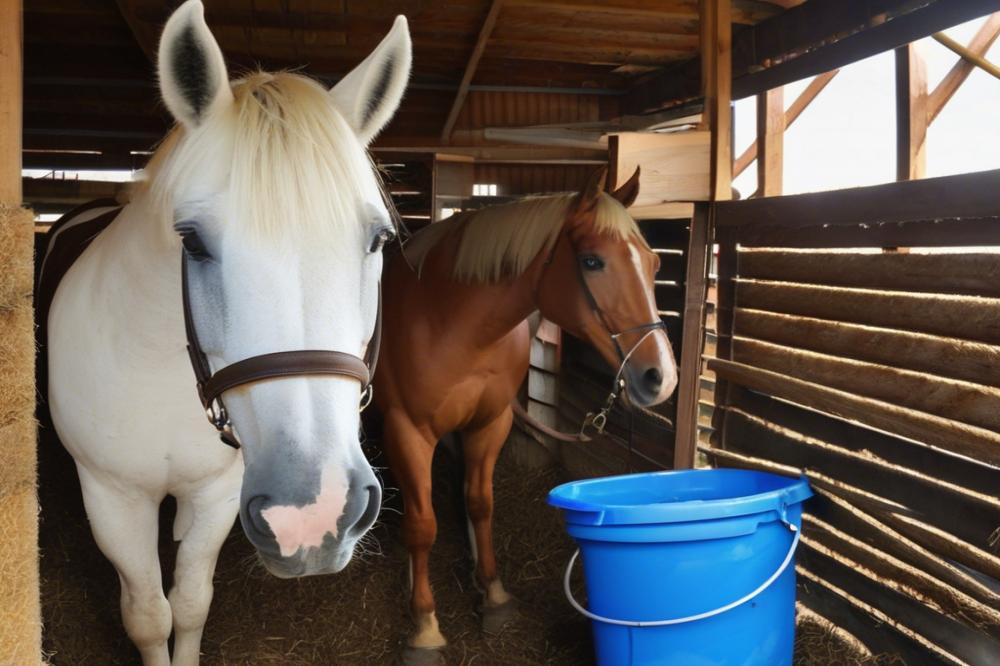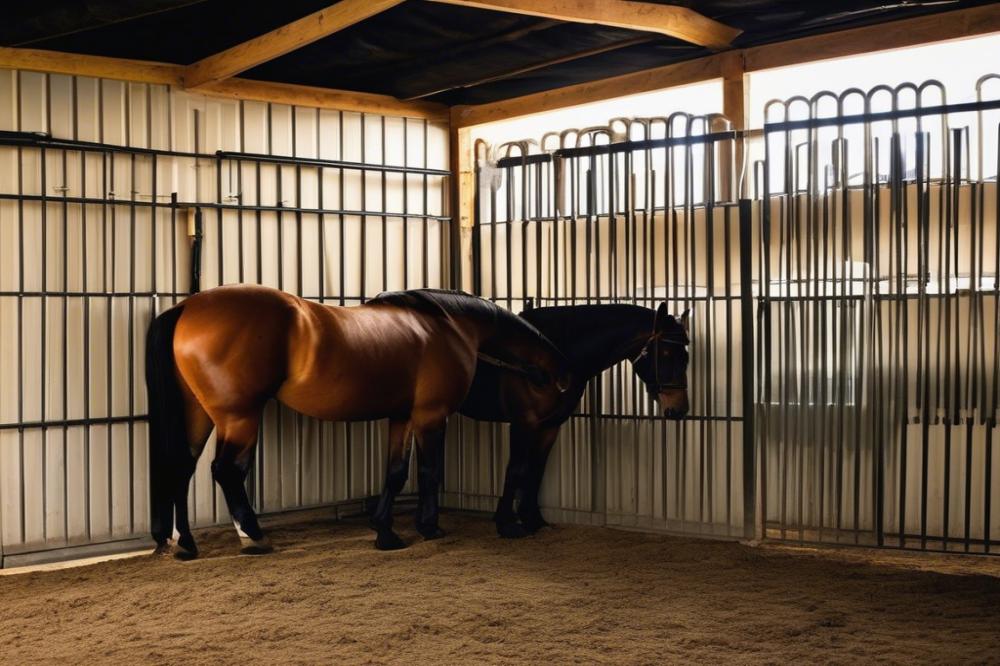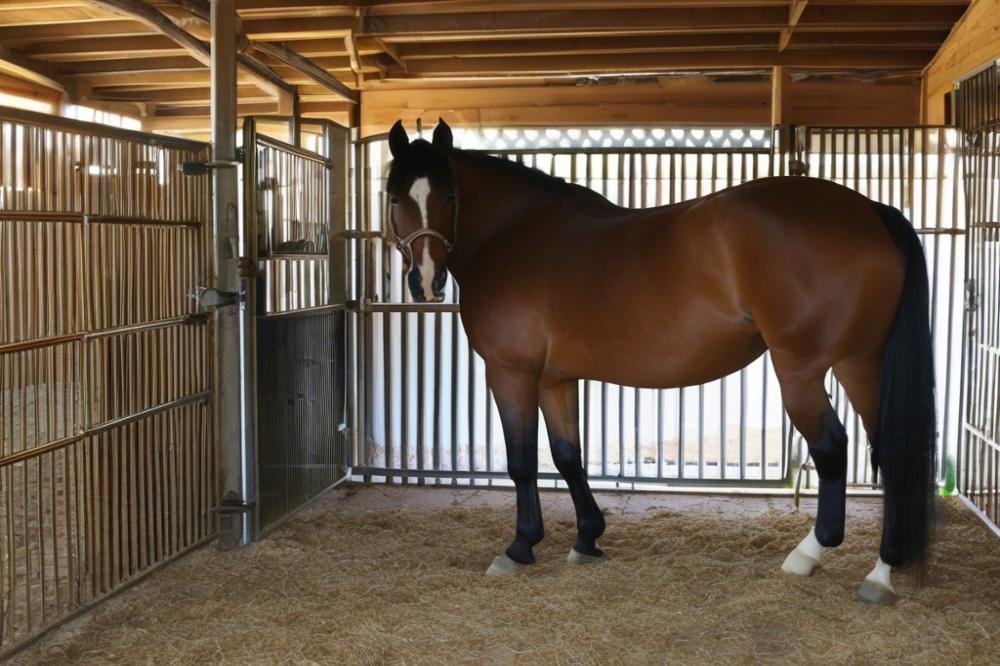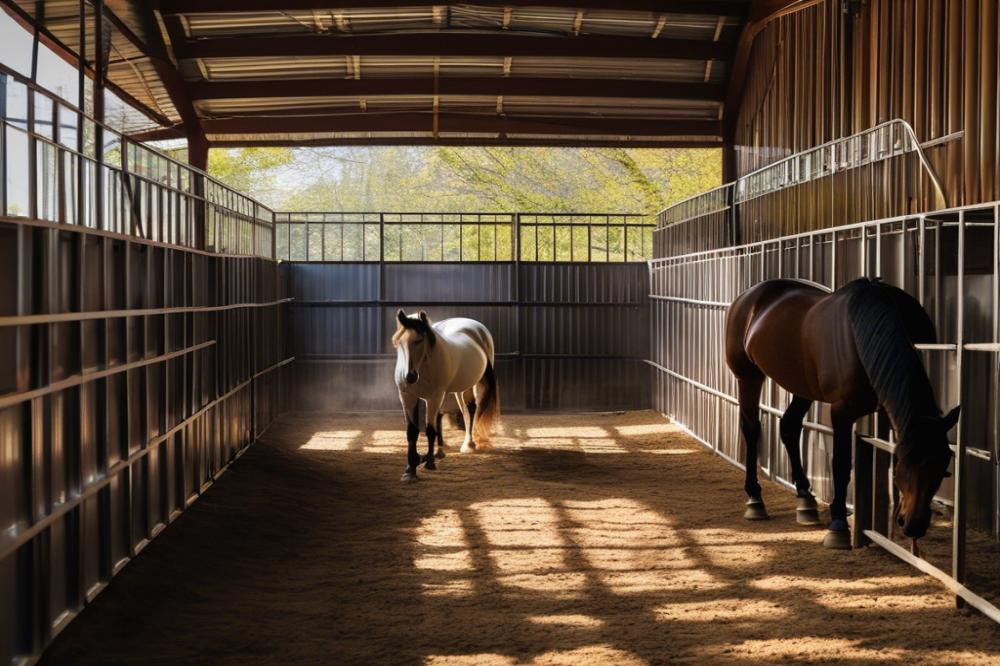Why Clean Horse Stalls Matter
Keeping horse stalls clean isn’t just about making things look tidy. It’s a crucial part of overall horse care. Imagine living in a messy room where stale air mingles with the smell of old hay and manure. Not exactly a cozy home, right? Similarly, horses deserve a clean environment, as it directly impacts their health and happiness.
When thinking about horse stall maintenance, one must prioritize equine hygiene. Unclean stalls can lead to respiratory issues and other health problems for our equine friends. If you’ve ever had a stuffy nose, you know how vital fresh air is! A horse’s respiratory system is sensitive, and dust and ammonia from dirty bedding can wreak havoc. Keeping those stalls clean helps to keep horses breathing easy and feeling good.
The Heart of Horse Health

Poorly maintained stalls can also lead to other health issues, such as colic or various infections. A horse that is uncomfortable or sick can show behavioral changes, making daily interactions less enjoyable for both horse and handler. Think of it as the foundation of a house; if that’s not solid, everything else is at risk. Clean stalls ensure not just a happy horse but also a happier owner!
This article will dive into the nitty-gritty of cleaning occupied horse stalls. We’ll discuss how often to clean them, the best practices to follow, and some tips that could make the task less of a chore. Whether you have a spunky pony or a majestic Thoroughbred, the efforts put into maintaining their living space will pay off in leaps and bounds. So, buckle up and let’s get started, because even a saddle for thoroughbreds deserves a clean environment!
The Takeaway

In summary, maintaining clean stalls is not a unique task but rather an essential part of horse stable management. The right level of cleanliness can keep your horse healthy and happy, which means less worry for you. Plus, you’ll be able to spend more time enjoying the things that really matter, like picking out the best vitamins for horses or just patting your trusted companion on the neck. Cleanliness may not be next to godliness, but in the world of horse care, it sure comes close!
Understanding Horse Stall Needs

When it comes to occupied stalls, there are special rules for cleaning. It goes beyond just a quick sweep. Regular cleaning is essential for the comfort and health of the horse.
Horse activity is a big factor. A lively horse might need more frequent cleanings than one who is more laid-back. If your equine buddy enjoys romping around his space, you might find more mess generated each day. Stall size also plays a role. Larger stalls can sometimes hide mess better, but that doesn’t mean they require less attention.
Bedding type has its own quirks. For instance, straw can look messy quicker than shavings. But hey, some horses just prefer it that way! Additionally, how absorbent the bedding is will influence how often you need to clean. A good quality material can reduce odor and make cleaning a breeze. Meanwhile, cheaper options might have you mucking out more often.
One thing to remember is that cleanliness directly affects equine hygiene. If a stall gets too dirty, it can hurt horse health. You wouldn’t want your horse standing in muck, right? Think of it as a little oasis for them. A clean environment can also chill your horse out and make them feel at home.
When considering horse care, don’t overlook the importance of routine. Daily checks can make all the difference. A quick visit each morning can catch messes before they grow. It’s like watering a plant. A little bit each day leads to a happier, healthier horse.
Equine housing isn’t just about space. It’s about creating a place that feels good and smells fresh. Each type of stall has its own unique needs. Keeping an eye on these factors will pave the way for better horse stable management.
Daily Cleaning Routine
Cleaning an occupied horse stall is essential for both horse comfort and health. Every day, a quick routine can make a huge difference. Start by picking up any manure. This step is crucial. Horses will naturally try to avoid soiled areas, which can be uncomfortable for them.
Next, look for wet spots in the bedding. A horse’s urine can soak deep into the straw or shavings, causing odor and breeding bacteria. Finding and removing these areas helps keep the stall clean. If you notice a wet spot, it’s best to dig it out and put in fresh bedding. This improves equine hygiene and keeps the stall inviting.
Identifying Areas Requiring More Attention
While you’re cleaning, keep an eye out for parts of the stall that need extra care. Manure piles can form quickly, especially if your horse tends to hang out in one spot. Over time, observing your horse will help you understand their habits. Does your horse favor one corner? That area will likely need more attention during clean-up.
Furthermore, checking the water bucket is essential. A clean water supply is part of good horse care. Dirty water can lead to health issues. Change it daily to encourage your horse to drink more. Hydration is key to their well-being.
Benefits of Daily Maintenance
Daily maintenance not only promotes a healthy living environment, but it also contributes to horse health overall. A clean stall reduces the chances of respiratory problems or infections. Who doesn’t want their horse to breathe easy? A fresh and tidy stall makes time spent in equine housing more enjoyable for your horse.
Moreover, ensuring a clean environment can save you time in the long run. It is much easier to deal with small messes every day than to face a mountain of muck after a week! You’ll thank yourself later when the task feels more manageable.
Lastly, let’s not forget the bond between you and your horse. A clean stall reflects your commitment to horse stable management. Your horse will feel comfortable and appreciated, not just by looking nice but also in their overall well-being. Just remember, happy horse, happy rider!
Weekly Deep Cleaning Practices
What Constitutes a Deep Clean for Occupied Stalls
Deep cleaning an occupied stall is more than just sweeping the floor. Think of it as giving your horse’s living space a full makeover. First, remove all bedding and clean out the manure. It’s important to dispose of any waste properly to keep the area fresh. After that, scrub down surfaces like walls and feeders. A good rinse with water can work wonders. Then, replace the bedding with fresh materials, creating a cozy spot for your equine friend.
Importance of Thorough Cleaning on a Weekly Basis
Weekly cleaning isn’t just a chore; it’s crucial for horse health and well-being. Dirty stalls can lead to respiratory issues or skin infections for your horse. It’s all about keeping the environment safe and comfortable. Plus, a clean stall can help spot any potential problems early on. Who wants to find a sneaky hoof abscess when they are mucking out? Staying on top of hygiene can also prevent odors from building up, making it more pleasant for both you and your horse.
Recommendations for Tools and Products Used in Deep Cleaning
When diving into the deep clean, having the right tools makes all the difference. A sturdy pitchfork is essential for getting rid of waste effectively. A broom and a shovel will help finish the job efficiently. For walls and surfaces, a solution of vinegar and water can clean without harsh chemicals. Many horse owners swear by natural cleansers, which can be gentler on equine housing. Don’t forget a good pair of gloves to keep things hygienic! Also, consider investing in high-quality bedding material that absorbs moisture well. A little preparation goes a long way in horse stall maintenance.
By keeping these practices in mind, you’re not only maintaining your horse’s living space but also contributing essential care. How often do you give your horse the royal treatment? Weekly deep cleaning is just part of the routine!
Signs That Stalls Need More Frequent Cleaning
Knowing when a stall needs a good scrub can save you from future headaches. Excessive odor is a good place to start. If the smell hits you like a wave when you open the door, it’s time to get to work. Fresh air should be the norm, not a rarity. You might also notice wet spots on the bedding, which signals moisture issues. Damp areas can lead to bigger problems like mold or parasites—definitely not fun for your horse.
Piles of manure are another clear sign. If it seems like you’re walking through a minefield, you might want to step up your horse stall maintenance routine. Observing your horse is important too. If your equine starts acting weird, it could be a sign of discomfort or stress caused by their environment. Even the quietest horse will show signs of annoyance if their space isn’t properly cleaned.
Health Implications of Neglecting Stall Cleanliness
When stalls go without proper care, serious health concerns can arise. Horses are sensitive creatures, and a dirty environment can lead to respiratory problems. Dust and ammonia can irritate lungs, causing coughing or even respiratory infections. No owner wants that! Maintaining equine hygiene isn’t just about aesthetics; it’s essential for keeping your horse healthy.
Ignoring the cleanliness of the stable can open the door for parasites as well. Flies and other pests love dirty spaces, and they carry diseases. Keeping the stall tidy means keeping those pesky bugs at bay. Furthermore, dirty bedding can cause skin issues—think rashes and infections. A little diligence can prevent these issues before they become a major headache.
Adjusting Cleaning Schedules Based on Seasonal Changes or Specific Conditions
Seasons change, and so should your cleaning habits. During the rainy months, for example, mud can become a nightmare. Wet conditions lead to more mess, so increase your cleaning frequency. In winter, stalls can get icy and slippery. Always keep an eye on the bedding for any frozen spots. Horses can slip if their footing isn’t stable.
Don’t forget about the unique challenges that come with summer. Heat brings more flies, which increases the urgency for thorough cleaning. More frequent mucking out is key to maintaining horse health during these months. A clean stall keeps them comfortable and less irritable when the weather gets hot.
Special conditions like injury or illness also call for a change in cleaning schedules. If a horse is sick, they might need extra attention in their living space. Close monitoring adds another layer of care to your horse’s stable management. Listening to your instincts and observing your equine can guide your cleaning needs.
Special Considerations for Different Situations
Cleaning an occupied horse stall isn’t a one-size-fits-all task. Each horse and situation can change the cleaning routine significantly. When you have multiple horses, the daily cleaning needs can multiply exponentially. A shared space means more waste, more mess, and more smell. Regular mucking is essential to keep equine housing fresh and safe. Imagine sharing a bathroom with a bunch of messy siblings! Not fun, right?
Foaling mares require additional attention. After giving birth, their stalls need to be spotless for both the mare and the foal. Bacteria and other nasties can put the newborn at risk. Spot cleaning becomes extremely important at this time. A quick daily inspection can help find soiled areas before they become a bigger issue. Horse care takes on new meaning when you’re managing a little one’s health as well. The earlier the mess is dealt with, the lower the risk of infection.
What happens when illness or injury strikes? A horse that is sick or recovering from an injury may not be as mobile. Keeping their area clean becomes a top priority. Mucking out becomes vital, as it’s essential for maintaining excellent equine hygiene during tough times. Look out for more frequent dirty spots. Your horse needs to lie down comfortably, and a clean space aids in their recovery.
Sometimes, cleaning can be a challenge if you’re dealing with sensitive or difficult horses. Some may not appreciate you moving about their stall. Others might throw a fit when you come with the shovel! Gentle approaches work wonders. Speaking softly while you go about your task can help keep them calm. If possible, try to get them used to your presence. Many horses enjoy a little chat while you work. A few carrots or treats as a reward for good behavior can make cleaning a more pleasant experience for both of you!
Horse stable management is all about finding the balance. Each horse has its own personality and quirks. Pay attention to your animal’s needs, and be ready to adjust your plans. Keeping that stall clean isn’t just about aesthetic looks; it’s about horse health and well-being too. Focusing on their comfort will encourage better behavior during those cleaning sessions. After all, a happy horse means smoother sailing for stall maintenance!
Best Practices for Efficient Stall Cleaning
Tips for Organizing Stall Cleaning Tasks
Organization makes a world of difference. Start by gathering all your cleaning supplies before diving in. Keep a sturdy wheelbarrow handy to shuttle away the soiled bedding and manure. Consider using buckets for water and cleaning agents. Label everything in your cleaning area, so you never waste time looking for tools.
Establish a routine for your tasks. For example, clean the stall in sections. Begin at the far corner and work your way toward the door. This way, you won’t miss any spots. Each stall could have a specific checklist, with items like ‘Remove droppings,’ ‘Replace bedding,’ and ‘Check for loose boards.’
Effective Time Management Strategies for Caretakers
Every minute counts in the world of horse care. Set a timer for each stall to keep yourself motivated. If you allot 20 minutes per stall, try to stick to it. That way, you won’t get bogged down and lose track of time.
Pair tasks whenever you can. For example, while you’re picking up droppings, think about how you can also check the water bucket. Multitasking like this saves time and keeps your horse stable management efficient.
Remember, skipping a day here and there can lead to a bigger mess later on. That increased workload is not something you want. Even small efforts go a long way when it comes to equine hygiene.
Advice on Maintaining a Balance Between Stall Cleanliness and Horse Comfort
Your horse’s comfort should never take a backseat to cleanliness. Fresh bedding is key to keeping your horse happy. However, avoid using too much material. Horses love to dig around in their stalls, and too thick bedding can lead to the formation of pockets where waste can gather.
It’s a fine line to walk. Regularly check for signs of discomfort, like shifting or kicking at the stall walls. Maintaining a cozy atmosphere with regular cleanings will keep your horse content.
In addition to visual cleanliness, consider smell. A clean stall should have a pleasant odor. This means good ventilation is crucial. If air isn’t circulating, even a clean stall can feel dank.
Lastly, share the cleaning duties if you can. Sometimes, a fresh set of hands (or two) makes the whole process much quicker. Plus, it turns into a social event, making work feel a bit less like a chore. Teamwork makes the dream work, especially in the world of equine housing!
Wrapping It Up
Cleaning occupied horse stalls is not just about keeping up appearances. It’s a crucial part of caring for these majestic creatures. A clean stall is like a fresh slice of apple pie—devoured with joy but often taken for granted. Horses deserve a healthy living environment, and regular cleaning promotes their well-being and comfort. Let’s face it, no one enjoys living in a messy space, including our four-legged friends.
Consider the numerous benefits of maintaining a tidy stall. A clean environment helps prevent health issues that can arise from dust, mold, and unsightly waste. Remember, a horse is more likely to thrive when their home is sparkling. Plus, it’s easier for you to spot signs of illness or discomfort when there’s less mess to sift through. Can you imagine trying to figure out if your horse is not feeling well while swimming through a sea of straw? Yikes!
So, how often should you roll up your sleeves and give those stalls a good scrub? Well, the answer might surprise you. It’s not a one-size-fits-all situation. Factors like the horse’s diet, the weather, and even your schedule play a role. The key is to find a routine that keeps both you and your horse happy. A good rule of thumb is to muck out daily and deep clean once a week. If you ask yourself, “Do horses sit down?” the answer is yes, but only if you create a cozy spot for them to do so!
As you establish your cleaning habits, keep in mind that consistency is your friend. Think of it like training for a marathon—slow and steady wins the race. It’s better to tackle little messes regularly than let them build up into overwhelming mountains of muck. Besides, your barn will be a pleasant place to be when it sparkles, and the horses will thank you in their own ways (like with an enthusiastic nicker).
Lastly, always remember the bigger picture of horse care. Using a horse due date calculator can help you stay ahead in organizing care routines, especially if you’re expecting a new foal. By prioritizing cleanliness and well-being, you’re not just managing a stall, you’re nurturing a lovely relationship with your horse. So, roll up those sleeves, grab a pitchfork, and get to it! Happy cleaning!



